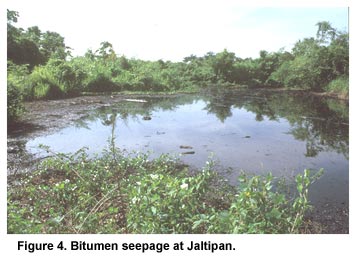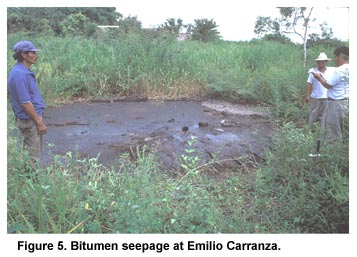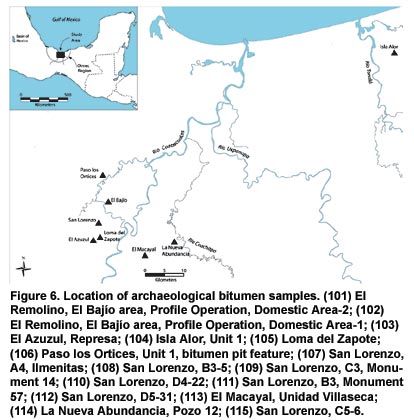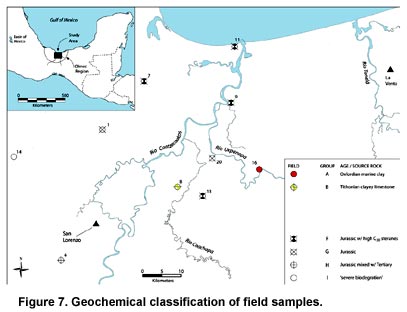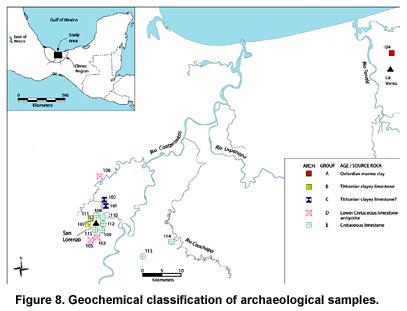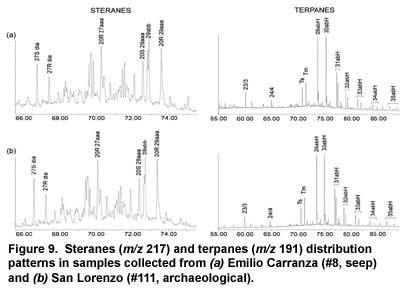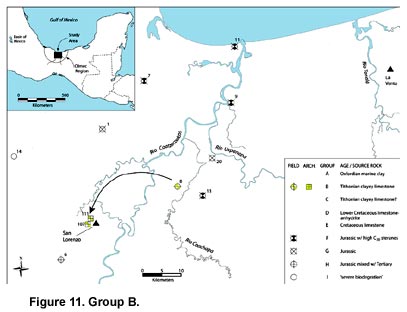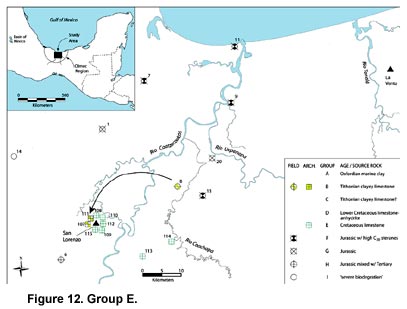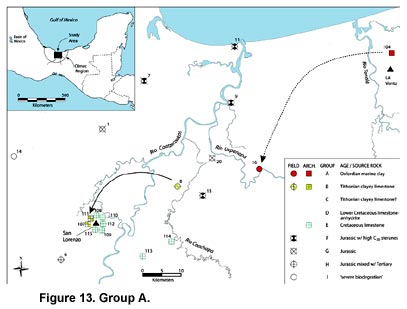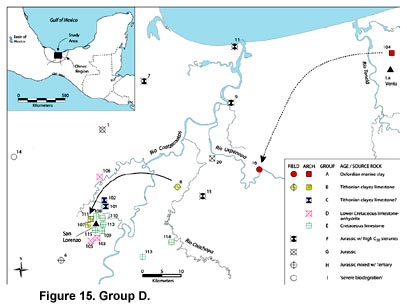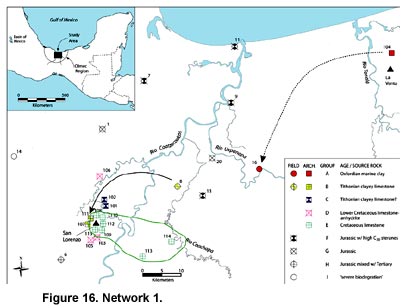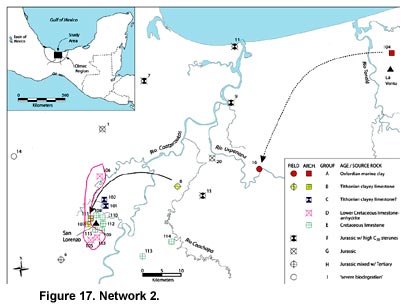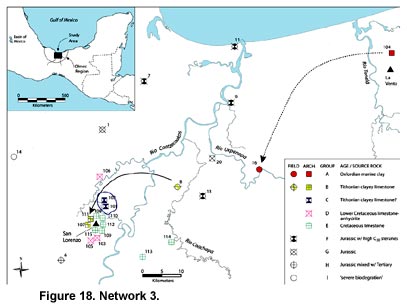
| FAMSI © 2006: Carl J. Wendt |
||
Bitumen Sourcing in the Olmec Region Bitumen Procurement and Exchange in the Olmec Region Geochemical studies in Mesoamerica have shown that petroleum produced in the Mexican Gulf Coast Basin (sampled mainly from deep wells) falls into five major chemically distinct groups, which reflect the environment and age of each formation–Oxfordian (two groups), Tithonian, Early Cretaceous, and Tertiary (Guzmán-Vega and Mello 1999). Wells producing chemically similar petroleum cluster into discrete surface areas (Guzmán-Vega and Mello 1999; Guzmán-Vega et al. 2001). In the Olmec region, wells in the eastern portion produce petroleum classified into at least two chemically and spatially distinct groupings belonging to the Tithonian oil family (Guzmán-Vega and Mello 1999). Initial field location of bitumen seeps was aided by a U.S. Navy report (Shufeldt 1872) that includes information on natural seeps around the Río Coatzacoalcos and its tributaries. I located and collected field samples from seven of the 16 seeps listed in the report, along with five others (Figure 3, Figure 4, Figure 5), using metal spoons and environmental sampling glass jars with Teflon lined closures. Bitumen lumps were also collected from the beach adjacent to the mouth of the Río Coatzacoalcos. Archaeological bitumen samples were acquired from Early Pre-Classic contexts at eight Olmec sites (Figure 6; Table 2). Ten field and 15 archaeological samples were analyzed by GC/MS for biomarker patterns. Bitumen samples were processed in the standard method and analyzed with full scan mode (50-550) and selective ion monitor (SIM) mode, and mass chromatograms of terpanes (m/z 191), steranes (m/z 217), monoaromatic steranes (m/z 253), and triaromatic steranes (m/z 231) were obtained. The distribution patterns of steranes and terpanes in the field samples allows them to be provisionally divided into six groups (Groups A-B and F-I) based on their biomarker features (Figure 7). All but one of the field samples probably derived from Pre-Tertiary source rocks (Upper Jurassic to Cretaceous). In contrast to the field samples, the distribution patterns of steranes obtained from archaeological samples generally look younger (less mature). The 15 archaeological specimens can be temporarily classified into five groups (Groups A-E; Figure 8), based on their biomarker characterizations. Some archaeological samples correlate well with their possible source material (seep bitumen) using geochemical features (biomarkers). Figure 9 shows that the distribution pattern of steranes and terpanes obtained from archaeological sample #111 (San Lorenzo, B3, Monument 57), is very similar to that from the field sample #8 collected from Emilio Carranza, and to crude oil produced from Upper Jurassic Tithonian formations (Guzmán-Vega and Mello 1999). Another correlation can be made for archaeological sample #104 (Isla Alor) and field sample #16 (La Concepción) (Figure 10). Their geochemical features also correlate moderately well with crude oil produced from the Upper Jurassic Oxfordian marine clay source rock collected from deep ocean wells in the southern Gulf of México (Guzmán-Vega and Mello 1999) about 400 km NE of Isla Alor and La Concepción. Geochemical parameters for both field and archaeological samples support their similarity. Some of the other archaeological samples (Groups D and E) look quite similar to bitumen derived from Cretaceous source rock (Guzmán-Vega and Mello 1999), based on the distribution patterns of steranes and terpanes. I thus believe that there is a good potential to locate seeps containing bitumen dating to the Cretaceous, which will enable us to correlate our results from archaeological bitumen to the potential source material. It is worth noting that although wells in the Olmec region produce petroleum classified into at least two chemically and spatially distinct groupings belonging to the Tithonian oil family, bitumen from seeps in the same region is much more chemically varied, belonging to the Oxfordian, Tithonian, and Tertiary oil families. What is more, archaeological bitumen data suggest that there are seeps in the region belonging to the Cretaceous oil family. Tracing archaeological bitumen to source locations is currently challenging due to the small number of bitumen seeps identified and the few samples collected and analyzed. Nonetheless, the seven archaeological samples from San Lorenzo fall into two groups (B and E). One group (B; Figure 11) with two samples correlates to bitumen collected from the Emilio Carranza seep ~23 km away. The other group (E; Figure 12) with five samples has similar chemical attributes as samples collected from the sites of El Macayal and La Nueva Abundancia. As mentioned above, the sample from Isla Alor (#104) correlates well with La Concepción bitumen (#16) located ~45 km away (Figure 13). While the Isla Alor sample could have been procured from La Concepción, it seems conceivable that it was obtained from an as yet unidentified seep situated closer to the site. The two samples collected from El Bajío are chemically similar to each other (Group C; Figure 14), but do not correlate to any seep material collected or to any published crude oil. The samples collected from Paso los Ortices, El Azuzul, and Loma del Zapote form the final group (D; Figure 15), and cannot currently be correlated to any seep, but I believe with the collection of more field samples there exists a good possibility to locate seeps with bitumen chemically similar to Group D (as well as Group E) archaeological bitumen, both of which appear to have originated in Cretaceous age reservoirs. During the Early Pre-Classic, Olmec living in sites surrounding San Lorenzo exploited a range of chemically distinct bitumen seeps. Certain seeps may have been preferred and exploited during different Early Pre-Classic phases, or the pattern might indicate that sites surrounding the regional center of San Lorenzo were incorporated in different procurement networks, reflecting a complex regional system of exchange and interaction. Sites with chemically similar archaeological bitumen samples form groups perhaps indicating the presence of at least three San Lorenzo regional networks represented by the following of sites: (i) San Lorenzo, El Macayal, and La Nueva Abundancia (Figure 16); (ii) Paso los Ortices, Loma del Zapote, and El Azuzul (Figure 17); and (iii) El Remolino (Figure 18). These groupings might also reflect some degree of independent procurement, where individuals obtained bitumen from local seeps on personal or group needs. More data are required to evaluate these ideas. |
||
|
Text links to all pages at this site are available at the FAMSI INDEX |
||

